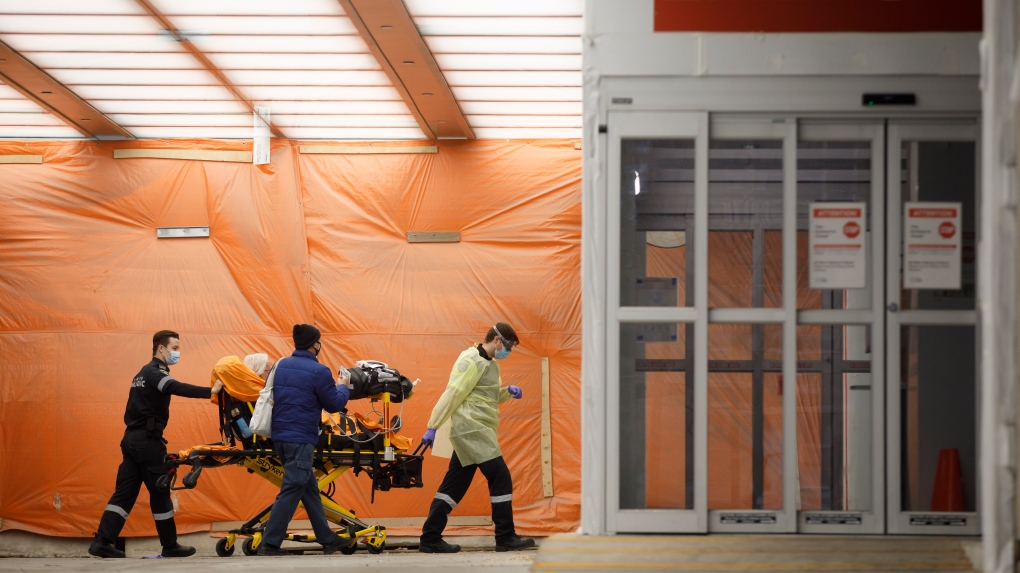Ontario allowing non-urgent, non-emergent surgeries to gradually resume
 Paramedics wheel a patient into the emergency department at Mount Sinai Hospital in Toronto, Wednesday, Jan. 13, 2021. THE CANADIAN PRESS/Cole Burston
Paramedics wheel a patient into the emergency department at Mount Sinai Hospital in Toronto, Wednesday, Jan. 13, 2021. THE CANADIAN PRESS/Cole Burston
Hospitals in Ontario are now allowed to gradually resume non-urgent and non-emergent surgeries and procedures.
Dr. Kieran Moore, the province's chief medical officer of health, announced Thursday he was lifting Directive 2 as the province continues to see a steady decline in COVID-19 hospitalizations and ICU admissions.
The directive was issued last month, ordering hospitals dealing with rising virus cases due to the Omicron variant to pause non-urgent and non-emergent surgeries and procedures.
"With encouraging trends and community transmission and our hospitalization and ICU admission trending downwards, we can now see that Omicron peak is behind us," Moore said.
"It's now time that we start focusing on resuming certain procedures in our health system, as well as the other aspects of our society that improve our social and well-being."
The province said it will be taking a planned phased approach in the resumption of surgeries and procedures in public hospitals and will be in alignment with the guidance by Ontario Health.
The approach, Moore said, entails hospitals initially increasing surgical capacity to 70 per cent before slowly moving up to 90 per cent. And he hopes that surgeries will return to normal volumes in late March and April when Moore said he anticipates the province will be in a recovery phase.
Moore explained that the gradual approach ensures that hospitals will not be overwhelmed.
"We don't want to suddenly open up all the doors and have our hospitals busy. We really need to understand some hospitals are still quite busy with COVID activity and there are regional variations in the level of COVID across Ontario," he said.
"We need to work as a system supporting each other -- all hospitals, our long term care and public health -- trying to ensure that patients can be provided the right care at the right time at the right place."
While Directive 2 has been lifted, Moore said Directive 2.1, which supports patient transfers, will remain in effect. He noted that some hospitals in other regions are still strained.
"As these services resume, it will be critical that our health system partners proceed cautiously and continue to demonstrate the tremendous partnership and collaboration they have shown to date so that all regions have the capacity to resume services slowly," Moore said.
Earlier this month, several medical and clinical activities were already allowed to resume, including diagnostic imaging, cancer screening, and non-urgent and emergent surgeries and procedures in pediatric specialty hospitals.
On Thursday, the number of people in hospital with COVID-19 dropped below 2,000 for the first time in more than a month.
CTVNews.ca Top Stories

Southern California wildfire destroys many structures; governor declares state of emergency
A wildfire whipped up by extreme winds swept through a Los Angeles hillside dotted with celebrity residences Tuesday, burning homes and forcing the evacuation of tens of thousands of people.
Trump is open to using 'economic force' to acquire Canada; Trudeau responds
Prime Minister Justin Trudeau said 'there isn’t a snowball’s chance in hell that Canada would become part of the United States,' on the same day U.S. president-elect Donald Trump declared that he’s open to using 'economic force' to acquire Canada.
A B.C. mom's real-life nightmare and the search to find her trafficked daughter
A Vancouver island mom shares the story of what happened to her teenaged daughter – and a warning for other parents about sex trafficking.
Liberal leadership hopeful Frank Baylis noncommittal on eliminating consumer carbon tax
Liberal leadership hopeful Frank Baylis says eliminating the consumer carbon tax alone will not 'solve the affordability issue for Canadians.'
Canadian naval vessel shadowed by Chinese war ship in the East China Sea
CTV National News is on board the HMCS Ottawa, embedded with Canadian Navy personnel and currently documenting their work in the East China Sea – a region where China is increasingly flexing its maritime muscle. This is the first of a series of dispatches from the ship.
Patient dies in waiting room at Winnipeg hospital
An investigation is underway after a patient waiting for care died in the waiting room at a Winnipeg hospital Tuesday morning.
Limit coffee-drinking to this time window to lower early death risk, study suggests
Drinking coffee has repeatedly been linked with better heart health and prolonged life. But the benefits of coffee consumption could depend on when you drink it, new research has found.
B.C. 'childbirth activist' charged with manslaughter after newborn's death
A British Columbia woman who was under investigation for offering unauthorized midwifery services is now charged with manslaughter following the death of a newborn baby early last year.
Man who exploded Tesla Cybertruck outside Trump hotel in Las Vegas used generative AI, police say
The highly decorated soldier who exploded a Tesla Cybertruck outside the Trump hotel in Las Vegas used generative AI including ChatGPT to help plan the attack, Las Vegas police said Tuesday.

































